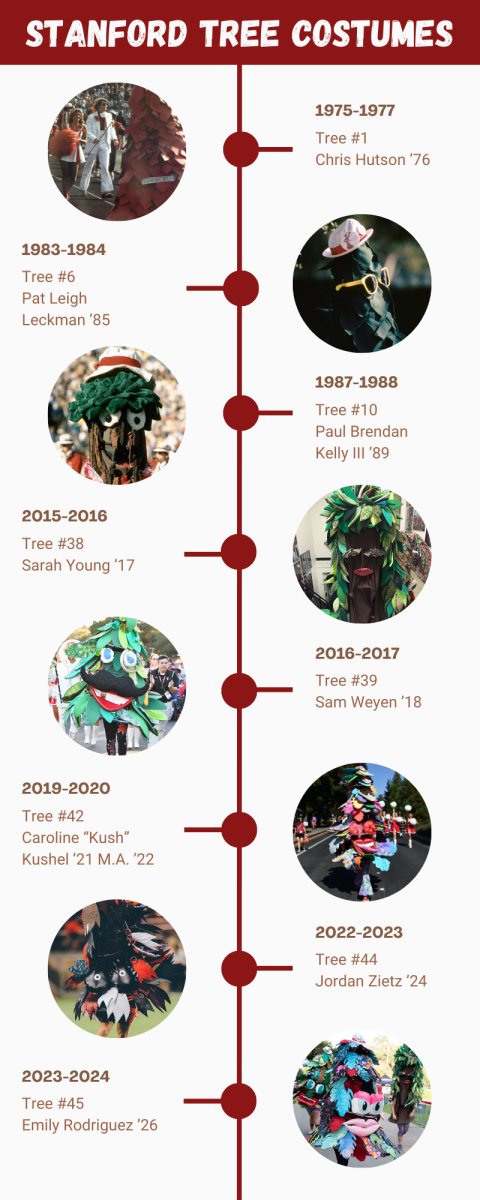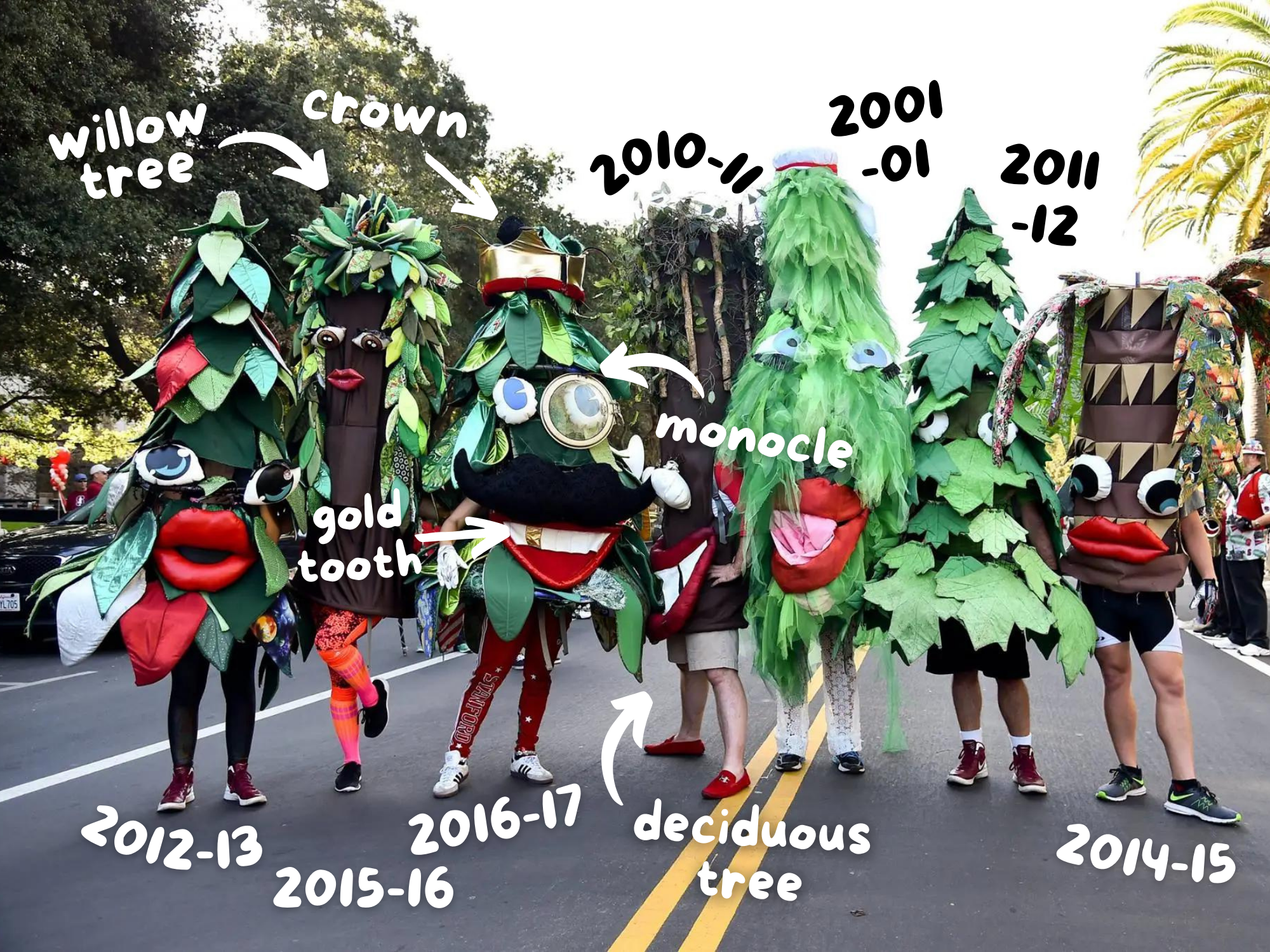No mascot has as unique a personality as the Stanford Tree. For nearly five decades, each Tree has made their costume distinctively, and fashionably, their own.
In 1975, Chris Hutson ’76, the first ever Tree, donned an entirely red and tree-shaped costume with a typed “Stanford” logo attached to the leaves. Continuing the monochromatic trend, Tree #6, Pat Leigh Leckman ’85, accessorized an all-green costume with a white hat and striking yellow sunglasses.
Playful statement pieces stayed in fashion until Tree #10, Paul Brendan Kelly III ’89, took over. He crafted a trunk-dominated tree with a cartoonish style, featuring a cropped jacket, shaggy leaf-hair and big eyes.
Creative possibilities of the Tree costume are nearly unlimited. A particularly notable costume can be found in Tree #42, Caroline “Kush” Kushel ’21 M.A. ’22, who crafted an entirely rainbow tree with patterned leaves, red swirly eyes and a tongue sticking out.
“I had just found out about Jimmy Hendrix and Janis Joplin,” Kushel said, referring to the 1960s counterculture movement as inspiration for the rainbow color. “I got really into the movement after writing a paper for a PWR class.”

Jordan Zietz ’24, Tree #44 who recently retired this May, created a similarly memorable costume covered entirely in red, black and white.
“My whole tree had a bit of a spooky vibe because I’m a die-hard horror fan,” Zietz said. “Plus, I wanted people to actually ‘fear the Tree’ for the first time in a while.”
Zietz’s suit was unabashedly himself. It included a note from his ex-girlfriend and leaves signed by celebrities as well as his family members.
“I was able to show the world, on such a large scale, the intricacies of the person that I am,” Zietz said. “It was almost like a montage of my life, out on display, for everyone to see.”
Emily Rodriguez ’26, the current tree (#45) and the first Central American Tree, used reversible leaves to make a costume inspired by Trees past.
“I wanted to use colors like Caroline, and when Big Game came around, I would flip all of my leaves so it would be a fully black and red Tree, inspired by Jordan’s costume,” Rodriguez said.
Making the costume can be challenging. Rodriguez had never sewn before. Zietz also learned to sew, weld and design his costume while in recovery from surgery.
“Every Tree comes out way more personalized than you’d think,” Rodriguez said, “It is very dependent on your skill sets and your creativity levels.”
Leaning into this imaginative and retrospective spirit, Sam Weyen ’18, Tree #39, drew his inspiration from Stanford lore. Weyen named his costume “Hue” as a nod to its vibrant color and David Hewes, who provided the golden spike that Leland Stanford pounded into the Transcontinental Railroad to mark its completion. Weyen’s costume also featured a gold tooth and monocle, referencing the Gilded Age.
Weyen lauded the Tree’s quirks: “Every Tree has been some version of nightmare fuel, and I hope that doesn’t stop.”
“If we have a Tree that looks legitimately cute in an athletic style, the way a Clemson Tiger looks, I would be so upset,” Weyen said.
Sarah Young ’17, Tree #38, also did not shy away from innovation. She crafted a vibrantly feminine willow tree for her suit. As the first Tree of color, Young said it was important to her “to have a prominent brown trunk and features that represented a departure from history.”
“I wanted my costume to stand out,” Young said. “I wanted it to visually represent the person that’s inside.”
According to Young, who remains involved in the Tree selection process, Trees since her are nearly exclusively from underrepresented backgrounds. “We wanted to make sure whatever was inequitable in the selection previously has been addressed and corrected,” Young said.
While the Tree costume’s future style remains a mystery, past and current Trees are devoted to maintaining its originality. Whether accessorized with a monocle, red lips or rainbow leaves, the Tree stands alone.
“I will be very proud of whatever my Tree baby comes up with, even if it’s the most hideous thing I’ve ever seen,” Rodriguez said.
Just as Trees have full freedom in crafting their own garbs, they expressed feeling liberated in the role.
“The Stanford Tree is so different from other mascots because we’re not technically a mascot,” Rodriguez said. “In other schools, being a mascot is portraying a character and comes with very specific rules.”
Being the Tree also felt liberating to Weyen, as it gave him “a license to misbehave.”
“It was my job to break the rules, to mess up, to fail, to be socially awkward and to be so violently myself that other people felt that same agency to be weird and be themselves too,” Weyen said.
“Being Tree is being the version of me that is a little more outgoing, a little more crazy, a little more stupid,” Rodriguez said. “It’s just a way to bring out that inner child, that inner joy, that inner crazy that a lot of people stow away once they get older.”
